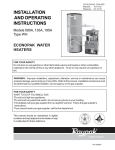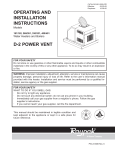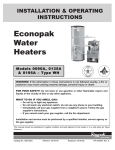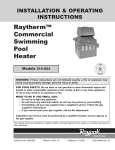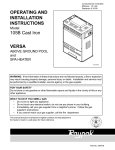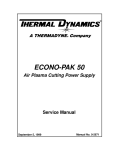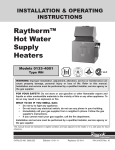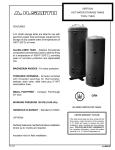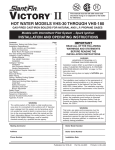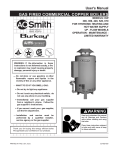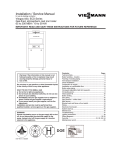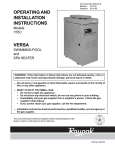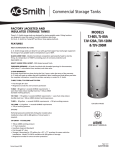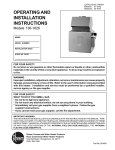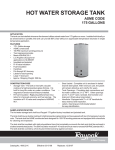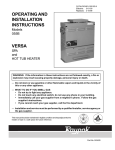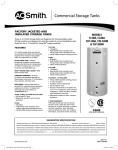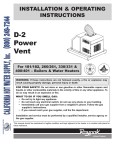Download Raypak 260-401 User's Manual
Transcript
CATALOG NO.
Effective:
Replaces:
3000.51D
07-15-06
08-01-03
INSTALLATION
AND OPERATING
INSTRUCTIONS
Models 260-401
Type WH
ECONOPAK
WATER HEATERS
Fig. #9166
FOR YOUR SAFETY
Do not store or use gasoline or other flammable vapors and liquids or other combustible
materials in the vicinity of this or any other appliance. To do so may result in an explosion
or fire.
WARNING: Improper installation, adjustment, alteration, service or maintenance can
cause property damage, personal injury or loss of life. Refer to this manual. Installation and
service must be performed by a qualified installer, service agency or the gas supplier.
FOR YOUR SAFETY
WHAT TO DO IF YOU SMELL GAS
*Do not try to light any appliance.
*Do not touch any electrical switch; do not use any phone in your building.
*Immediately call your gas supplier from a neighbor's phone. Follow the gas supplier's
instructions.
*If you cannot reach your gas supplier, call the fire department.
This manual should be maintained in legible
condition and kept adjacent to the heater or kept
in a safe place for future reference.
P/N 240726 Rev. 1
TABLE OF CONTENTS
CONTENTS
3
1. RECEIVING EQUIPMENT
3
4
2. GENERAL SPECIFICATIONS AND DIMENSIONS
General Safety Precautions
6
6
6
6
7
8
10
11
13
14
3. INSTALLATION PROCEDURES
- Code Requirements
- Clearance Requirements for all Models
- Combustion/Ventilation Air
- Venting Connections
- Common Vents
- Gas Supply Connections
- Water Connections & System Piping
- Electrical Wiring
- Wiring Diagrams
19
19
19
24
25
4. SERVICING PROCEDURES
- Sequence of Operation
- Start Up Procedures
- Inspection Procedures
- Repair Section
26
30
5. TROUBLE SHOOTING GUIDE
- Adjustments/Replacements of Components
33
6. REPLACEMENT PARTS LIST
35
WARRANTY
These instructions are provided to assure the proper installation and operation of Raypak
water heaters. Should questions arise regarding the specifications, installation, operation or
servicing of these water heaters, we suggest that the local Sales representative or the factory
be consulted.
2
1. RECEIVING EQUIPMENT
On receipt of your equipment it is suggested that you visually check for external damage to the carton. If the
carton is damaged, it is suggested that a note be made on the Bill of Lading when signing for equipment. Remove
the heater from the carton and if it is damaged report the damage to the carrier immediately. Be sure that you receive
the number of packages indicated on the Bill of Lading. Claims for shortages and damages must be filed with
carrier by consignee.
Purchased parts are subject to replacement only under the manufacturer's warranty. Debits for defective
replacement parts will not be accepted and defective parts will be replaced in kind only per our standard warranties.
When ordering parts, you must specify Model and Serial Number of the heater. When ordering under warranty
conditions, you must also specify date of installation.
Raypak recommends that this manual be reviewed thoroughly before installing your Raypak heater.
If there are any questions which this manual does not answer, please contact your local Raypak
representative.
2. GENERAL SPECIFICATIONS
The Raypak water heaters are design certified by the and tested under the requirements of the American National
Standard, ANSI Z21.10.3. Each heater has been constructed and pressure tested in accordance with the
requirements of Section IV of the American Society of Mechanical Engineers Code, and factory fire tested.
These heaters are designed for indoor and outdoor installations, and can be installed on combustible flooring
when the appropriate listed floor shield base is used. Models are available with standing pilot or with intermittent
ignition device (IID), and are equipped with the following components as standard: water circulation pump, pressure
relief valve, manual reset high limit switch, fast response temperature controller, vent thermal and flame roll-out
switches (except for models 330 and 400), a solid state Economaster pump control relay, 40VA transformer, and
redundant combination gas valve for use with either Natural or Propane gases. A tankstat is supplied loose for
installation in the field.
SPECIFICATIONS AND DIMENSIONS
‡ Recovery based on manufacturer's rating
*May be used with other tank size capacity.
Fig. #9464
3
!
General Safety Precautions
Be sure to read and understand the entire Instruction Manual before attempting to install or operate this water heater. Pay
particular attention to the following general Safety Precautions. Failure to follow these warnings could result in a fire or
explosion, causing property damage, bodily injury or death. Should you have any problems understanding the instructions
in this manual, STOP, and get help from a qualified installer or service technician or the gas supplier.
! WARNING
! DANGER
Gasoline, as well as other flammable materials and liquids
(adhesives, solvents, etc.), and the vapors they produce, are
extremely dangerous. DO NOT handle, use or store gasoline
or other flammable or combustible materials anywhere near
or in the vicinity of a water heater. Be sure to read and follow
the warning label pictured below and other labels on the water
heater, as well as the warnings printed in this manual. Failure
to do so can result in property damage, bodily injury, or death.
LIQUEFIED PETROLEUM MODELS – Propane, or LP gas,
must be used with great caution.
• It is heavier than air and will collect first in lower areas
making it hard to detect at nose level.
• Make sure to look and smell for LP leaks before attempting
to light appliance. Use a soapy solution to check all gas fittings
and connections. Bubbling at a connection indicates a leak
that must be corrected. When smelling to detect an LP leak,
be sure to sniff near the floor too.
• Gas detectors are recommended in LP applications and
their installation should be in accordance with the
manufacturer's recommendations and/or local laws, rules,
regulations or customs.
• It is recommended that more than one method be used to
detect leaks in LP applications.
IF LP GAS IS PRESENT OR SUSPECTED:
• DO NOT attempt to find the cause yourself;
• DO NOT try to light any appliance;
• DO NOT touch any electrical switch;
• DO NOT use any phone in your building.
• Leave the building immediately and make sure that everyone else leaves also.
• Leave the doors open for ventilation and contact the gas
supplier, a qualified service agency or the fire department.
• Keep the area clear until the service call has been made, the
leak is corrected, and a qualified agency has determined the
area to be safe.
! DANGER
Failure to install the draft hood and properly vent the water
heater to the outdoors as outlined in the Venting Section of this
manual can result in unsafe operation of the water heater. To
avoid the risk of fire, explosion, or asphyxiation from carbon
monoxide, never operate this water heater unless it is properly
vented and has an adequate air supply for proper operation.
Be sure to inspect the vent system for proper installation at
initial start-up; and at least annually thereafter. Refer to
Maintenance section of this manual for more information
regarding vent system inspections.
! WARNING
Vapors from
flammable liquids will
explode and catch fire
causing death or severe
burns.
Do not use or store flammable
products such as gasoline
solvents or adhesives in the
same room or area near the
water heater.
Keeflammable products:
1. far away from heater,
2. in approved containers,
3. tightly closed and
4. out of childrens reach.
Installation:
Do not install water heater
where flammable products
will be stored or used unless
the main burner and pilot flames
Both LP and natural gas have an odorant added to help
detection. Some people may not physically be able to smell
or recognize this odorant. If unsure or unfamiliar about the
smell associated with LP or natural gas, ask the gas supplier.
Other conditions, such as "Odorant Fade", which causes the
odorant to "fade", or diminish in intensity can also hide or
camouflage a gas leak.
Water heater has a main
burner and pilot flame.
The pilot flame:
1. is on all the timeand
2. will ignite flammable
vapors.
Vapors:
1. cannot be seen,
2. are heavier than air,
3. go a long way on the
floor,
4. can be carried from other
room to the pilot flame by
their currents.
! DANGER
Water heaters utilizing Liquefied Petroleum gas (LP) are
different from natural gas models. A natural gas heater will not
function safely on LP gas and vice versa. Conversion from
Natural gas to LP gas (or vice versa) must be done by a
qualified service technician. To avoid possible equipment
damage, personal injury or fire: DO NOT connect this water
heater to a fuel type not in accordance with unit data plate.
Propane for propane units. Natural gas for natural gas units.
These units are not certified for any other type fuel.
! WARNING
are at least 18" above the
floor. This will reduce, but
not eliminate, the risk of
vapors being ignited by the
main burner or pilot flame.
LP appliances should not be installed below-grade (for example, in a basement) if such installation is prohibited by
federal, state and/or local laws, rules, regulations or customs.
Read and follow water heater warnings and instructions. If owners
manual is missing, contact the retailer or manufacturer.
4
General Safety Precautions
To meet commercial hot water requirements, the
tankstat is adjustable up to 190°F. However, water
temperatures over 125°F. can cause severe burns
instantly or death from scalds. This is the preferred
starting point for setting the control for supplying general purpose hot water.
The following chart details the relationship of water
temperature and time with regard to scald injury and
may be used as a guide in determining the safest water
temperature for your applications.
Temperature
120°F.
Safety and energy conservation are factors to be
considered when setting the water temperature on the
tankstat. The most energy efficient operation will result
when the temperature setting is the lowest that satisfies the needs consistent with the application.
Time to Produce Serious Burn
More than 5 minutes
125°F.
130°F.
1-1/2 to 2 minutes
About 30 seconds
135°F.
140°F.
About 10 Seconds
Less than 5 seconds
145°F.
150°F.
Less than 3 seconds
About 1-1/2 seconds
155°F.
About 1 second
Table courtesy of Shiners Burn Institute
TIME/TEMPERATURE
SCALDS
RELATIONSHIPS
IN
The temperature of the water in the storage tank boiler
can be regulated by setting the temperature dial on
front of the tankstat. To comply with safety regulations,
the tankstat was set at its lowest setting before shipment from the factory. The illustration below illustrates
the tankstat and how to adjust the water temperature.
To adjust the water temperature,
insert a small straight screwdriver
into slotted screw in hole in front
of tankstat and turn wheel to
desired setting. Thermostat is
adjustable up to 190°F.
Water temperature over 125°F can cause
severe burns instantly or death from
scalds.
CAUTION!! - Hotter water
increases the risk of
SCALDING!
Children, disabled and elderly are at highest risk of being scalded.
See instruction manual before setting
temperature at tankstat.
Feel water before bathing or showering.
Temperature limiting valves are available,
see manual.
Maximum water temperatures occur just after burner
has shut off. To find hot water temperature being
delivered, turn on a hot water faucet and place a
thermometer in the hot water stream and read the
thermometer.
There is a Hot Water SCALD Potential if the tankstat is
set too high.
NOTE: When this water is supplying general purpose
hot water requirements for use by individuals, a thermostatically controlled mixing valve for reducing point
of use water temperature is recommended to reduce
the risk of scald injury. Contact a licensed plumber or
the local plumbing authority for further information.
5
3. INSTALLATION PROCEDURES
CODE REQUIREMENTS
Installation must be in accordance with local codes, or, in the absence of local codes, with the latest editions
of the National Fuel Gas Code, ANSI Z223.1,/NFPA 54, and the National Electrical Code, ANSI/NFPA 70. In
Canada installations must conform with the current CAN/CSA B149.1 and the Canadian Electrical Code Part 1
CSA C22.2 No.1. Where required by the authority having jurisdiction, the installation must conform to American
Society of Mechanical Engineers Safety Code for Controls and Safety Devices for Automatically Fired Heaters, CSD1.
MOUNTING BASE
The heater should be mounted on a level, noncombustible surface. Heater must not be installed on carpeting.
The heater can be installed on a combustible surface only when the appropriate listed floor shield base is provided.
An optional listed floor shield base is available for factory installation with the heater on all indoor models.
NOTE: The heater should be located in an area where water leakage will not result in damage to the area adjacent
to the appliance or to the structure. When such locations cannot be avoided, it is recommended that a suitable drain
pan, adequately drained, be installed under the appliance. The pan must not restrict air flow.
In addition, the heater shall be installed such that the gas ignition system components are protected from water
(dripping, spraying, rain, etc.) during appliance operation and service (circulator replacement, control replacement,
etc.).
CLEARANCE REQUIREMENTS FOR ALL MODELS
1. Minimum clearances from combustible surfaces.
Floor
Front
(1)
(2)
Comb. Alcove
Back
Right
Left
12"
12"
12"
Top
(Indoor)
39"
Top
(Outdoor)
Unobstructed
Flue
Vent
6"
(1) Except for carpeted flooring, heaters are certified for installation on combustible floors, when equipped
with listed floor shield base.
(2) A front clearance of at least 24" is recommended for adequate service of burner-tray and controls.
COMBUSTION/VENTILATION AIR (Indoor models only)
WARNING: Air supply to the heater room must not be affected by mechanical exhaust vents located in other parts
of the house, such as kitchen or bathroom fans, or attic blowers. Mechanical exhaust vents may create a negative
pressure condition in the heater room that can become a hazard of asphyxiation, explosion or fire.
CAUTION: Combustion air must not be contaminated by corrosive chemical fumes which can damage the heater.
Measures must be taken to prevent the entry of corrosive chemical fumes to the combustion and ventilation air
supply. Such chemicals include, but are not limited to, chlorinated and/or fluorinated hydrocarbons such as found
in refrigerants, aerosol propellants, dry-cleaning fluids, degreasers, and paint removers. Other harmful elements may
come from bleaches, air fresheners, or mastics. Vapors from these types of products can form corrosive acid
compounds when burned in a gas flame. The resulting acid condensate can damage or substantially reduce the life
of the heater. It may be necessary to provide outside air directly to the heater in order to avoid this problem.
6
1) The heater must be provided with adequate supply
of air for proper combustion and ventilation in
accordance with the latest edition of the National
Fuel Gas Code, ANSI Z223.1, or applicable provi
sions of the local building codes.
2) When the heater is installed in a confined space
where all air is supplied from inside the building, the
heater room must be provided with two openings,
each one having a minimum net free area, in square
inches as follows:
Model
260
330
400
OUTDOOR MODELS
Heaters must not be installed under an overhang of
less than three (3) feet from the top on the heater. Three
(3) sides must be open in the area under the overhang.
Roof water drainage must be diverted away from the
heater installed under overhangs with the use of gutters.
The point from where the flue products exit the heater
must be a minimum of four (4) feet below, four (4) feet
horizontally from or one (1) foot above any door, window
or gravity inlet to a building. The top surface of the heater
shall be at least three (3) feet above any forced air inlet,
or intake ducts located within ten (10) feet horizontally.
In areas where high winds are frequent, it may be
necessary to locate the heater a minimum of 3' from high
vertical walls, or install a wind break so the heater is not
in direct wind current.
Sq. In. Of Free Area
264
333
399
One opening shall be within 12 inches of the top, and the
other opening within 12 inches of the floor. If additional
gas appliances are installed in the same space, the total
input of all gas appliances installed in the same space,
must be considered in the calculation. Refer to Sec.
5.3.5 of the latest edition of the National Fuel Gas Code
for additional requirements.
VENTING CONNECTIONS (Outdoor Models)
Outdoor vent top is shipped separately and must be
installed on site.
MODELS 260-401
Step 1: Insert screw retainer clip over mounting flange,
(4 places).
NOTE: If louvers, grills or screens are used on the
openings, obtain the net free area from their supplier or
manufacturer. If the design free area of a louver is not
known nor available, it shall be assumed that wood
louvers will have 20-25 percent free area and metal
louvers will have 60-75 percent free area as shown in the
National Fuel Gas Code.
Fig. #8280.1
Step 2: Attach mounting angles to heater jacket with
1/2" sheetmetal screws, (4 places).
3. If the heater room is located against an outside wall
and air openings can communicate directly with the
outdoors, the two openings on the out side wall must
each have a net free area, in square inches as follows:
Model
260/261
330/331
400/401
Sq. In. Of Free Area
66
84
100
Fig. #8281.1
Step 3: Lower outdoor top to heater and secure with 1"
sheetmetal screws.
Location of the openings is the same as in the previous
case - that is, within 12 inches of the top, and within 12
inches of the bottom of the enclosure. If horizontal ducts
are used, the area must be doubled and the duct area
shall not be less than the area of the openings they
connect, and in no case shall the smallest dimension be
less than 3 inches.
LONG SIDE OF MOUNTING
ANGLE LOCATED AS SHOWN
7
VENTING CONNECTIONS (Indoor Models)
The drafthood is shipped separately and must be installed on the heater.
For Model 260/261:
1. Mount drafthood on top of heater and attach with the 4 sheet metal screws provided. Drafthood should be
positioned with the vent sensor located on the front left side as shown.
2. Remove plastic plug from left side of heater jacket and install plastic grommet provided.
3. Route flue sensor wire harness through the grommet installed in Step 2.
Fig. #9351
4. Remove door and locate wire from roll out sensor to Hi Limit with the male/female connector.
WIRE FROM TRANSFORMER
WIRE FROM TRANSFORMER
MALE/FEMALE
WIRE TERMINAL
CONNECT ONE VENT SENSOR WIRE
TO HIGH LIMIT WIRE
WIRE FROM HIGH LIMIT
CONNECT ONE VENT SENSOR WIRE
TO ROLL OUT SENSOR WIRE
ROLL OUT SENSOR
ROLL OUT SENSOR
Before Installation of Draft Hood
After Installation of Draft Hood
Fig. #8947.2
Fig. #8947.3
5. Disconnect male/female connector and attach to the 2 wires from drafthood vent sensor harness.
8
If installation requires horizontal runs, the vent pipe
must have a minimum of 1/4 inch per foot rise and
should be supported at not more than five foot
intervals.Plumbers tape, crisscrossed, will serve to
space both horizontal and vertical piping. Maximum
vent connector horizontal length shall be 1-1/2 feet (18
inches) for each inch of connector diameter as follows:
MODELS 330/331 AND 400/401
VENT TERMINAL/INDOOR STACK INSTALLATION
1. Remove the louvered jacket top by removing
four (4) #10 flat head screws.
2. If originally installed, remove "Pagoda" top
from the louvered jacket top.
3. Place the inner stack adapter panel over the
flue collector inside the heater. Make sure
the flanged side of the flue opening is up.
4. Turn the stack (draft hood) up side
down and set it down bottom side up.
5. Turn the jacket top panel (removed in step 1) up
side down and place it through the stack.
6. Attach the three (3) mounting brackets to the
stack using the screws provided and the holes
that are pre-drilled in the stack. Make sure the
brackets are positioned with the flange near
the top side of the stack (see illustration).
Caution must be taken not to over tighten and
strip the screw threads.
7. Turn the assembled stack and jacket top, right side
up. The jacket top will be trapped between the
brackets and the top of the stack. Place the stack
over the inner adapter panel flanged hole and
lower the louvered jacket top panel back into its
original position. Reinstall the four (4) green #10
flat head screws removed in step 1 above.
Heater Size
260/261
330/331
400/401
Vent Connector
Diameter
8"
9"
10"
Max Horizontal
Length - FT
12.0
13.5
15.0
Gas vents supported only by the flashing and extending above the roof more than five feet should be
securely guyed or braced to withstand snow and wind
loads. We recommend use of insulated vent pipe
spacer through the roofs and walls.
For protection against rain or blockage by snow, the
vent pipe must terminate with a listed vent cap which
complies with the local codes or, in the absence of such
codes, to the latest edition of the National Fuel Gas
Code, ANSI Z223.1.
The discharge opening must be a minimum of two
feet vertically from the roof surface and at least two(2)
feet higher than any part of the building within ten (10)
feet. Vent stack shall be at least five (5) feet in vertical
height above the drafthood outlet. The vent cap
location shall have a minimum clearance of four (4)
feet horizontally from, and in no case above or below,
unless a 4-foot horizontal distance is maintained, from
electric meters, gas meters regulators and relief equipment.
The weight of the vent stack or chimney must not rest
on boiler draft hood. Support must be provided in
compliance with applicable codes. The heater top and
draft hood must be readily removable for maintenance
and inspection. Vent pipe should be adequately supported to maintain proper clearances from combustible
construction.
Type "B" double wall or equivalent vent pipe is
recommended. However single wall metal vent pipe
may be used as specified in the latest edition of the
National Flue Gas Code ANSI Z223.1.
Fig. # 8246.6
WARNING: Indoor heater require a drafthood that
must be connected to a vent pipe and properly vented
to the outside. Failure to follow this procedure can
cause fire or fatal carbon monoxide poisoning.
Vent piping the same size or larger than the draft
hood outlet is recommended, however, when the total
vent height is at least ten (10) feet (draft hood relief
opening to vent terminal), the vent pipe size may be
reduced as specified in the National Fuel Gas Code,
ANSI Z 223.1. As much as possible avoid long horizontal
runs of vent pipe and too many elbows.
Fig. #8119.2
9
WARNING: These heaters must not be connected into
any portion of mechanical draft systems operating
under positive pressure. To do so may cause the flue
products to be discharged into the living space causing
serious health injury.
For connections to gas vents or chimneys, vent
installations shall be in accordance with Part 7, Venting
of Equipment, of the National Fuel Gas Code, ANSI
Z223.1, or applicable provisions of the local building
codes.
COMMON VENTS
Manifolds that connect more than one
heater to a common chimney must be
sized to handle the combined load.
Consult available guides for proper
sizing of the manifold and the chimney.
At no time should the area be less than
the area of the largest outlet.
(e) Test for spillage at the draft hood relief opening
after 5 minutes of main burner operation. Use the
flame of a match or candle, or smoke from a
cigarette, cigar or pipe to visually check spillage.
(f) After it has been determined that each appliance
remaining connected to the common venting system properly vents when tested as outlined above,
return doors, windows, exhaust fans, fireplace
dampers and any other gas burning appliance to
their previous conditions of use.
(g) Any improper operation of the common venting
system should be corrected so the installation conforms with the latest edition of the National Fuel
Gas Code, ANSI Z223.1. When re-sizing any
portion of the common venting system, the common venting system should be re-sized to
approach the minimum size as determined using
the appropriate tables in Chapter 10 and in appendix
G of the National Fuel Gas Code, ANSI Z223.1 and
CAN/CSA-B149.1.
GAS SUPPLY CONNECTIONS
Fig. # 9463
At the time of removal of an existing heater, the
following steps shall be followed with each appliance
remaining connected to the common venting system
placed in operation, while the other appliances remaining connected to the common venting system are not
in operation.
(a) Seal any unused openings in the common venting
system.
(b) Visually inspect the venting system for proper size
and horizontal pitch and determine there is no
blockage or restriction, leakage, corrosion and
other deficiencies which could cause an unsafe
condition.
(c) Insofar as is practical, close all building doors and
windows and all doors between the space in which
the appliances remaining connected to the common venting system are located and other spaces
of the building. Turn on clothes dryers and any
appliance not connected to the common venting
system. Turn on any exhaust fans, such as range
hoods and bathroom exhausts, so they will operate at maximum speed. Do not operate a summer
exhaust fan. Close fireplace dampers.
(d) Place in operation the appliance being inspected.
Follow the lighting instructions. Adjust tankstat
so appliance will operate continuously.
The inlet gas connection to the heater gas valve is
1/2" for model 203; 3/4" for models 260 and 330; and
1" for model 400. Provide an adequate gas supply line
no smaller than 1/2", according to the chart below:
MAXIMUM EQUIVALENT PIPE LENGTH (FEET)
NATURAL GAS 1000 BTU/FT .60 SPECIFIC GRAVITY @ 0.5" W.C. PRESSURE DROP
PROPANE GAS 2500 BTU/FT 1.53 SPECIFIC GRAVITY @ 0.6" W.C. PRESSURE DROP
Gas piping must have a sediment trap ahead of the
boiler gas controls, and a manual shut-off valve located
outside the heater jacket. All gas piping should be tested
after installation in accordance with local codes.
Gas Inlet
Manual Shut Off Valve
Gas
Valve
Heater Jacket
Sediment
Trap
Union
Fig. # 8090.1
10
CAUTION: The heater and its manual shut off valve must be disconnected from the gas supply during any
pressure testing of that system at test pressures in excess of 1/2 PSIG(3.45 KPA). Dissipate test pressure in
the gas supply line before reconnecting the heater and its manual shut off valve to gas supply line. FAILURE TO
FOLLOW THIS PROCEDURE MAY DAMAGE THE GAS VALVE. OVER PRESSURED GAS VALVES ARE
NOT COVERED BY WARRANTY. The heater and its gas connections shall be leak tested before placing the
appliance in operation. Use soapy water for leak test DO NOT use open flame.
NOTE: Do not use teflon tape on gas line pipe thread. A flexible sealant suitable for use with Natural and Propane
gases is recommended.
GAS PRESSURE-SPECIFICATIONS
Natural
Propane
Inches
Min.
7.0
12.0
W.C.
Max.
10.5
13.0
Regulator
Setting
4.0
11.0
Note: Do not exceed maximum inlet gas pressure. The minimum value shown is for input adjustment.
GAS PRESSURE REGULATOR
The gas valve is provided with pressure taps to measure gas pressure upstream of the gas valve and
downstream which is the same as the manifold pressure.
The gas pressure regulator is preset and sealed at 4" W.C. for natural gas, and 11" W.C. for propane gas.
Between the gas valve and the burners is a 1/8" pipe plug. The pressure at this point, taken with a manometer,
should be about 3.7" W.C. natural gas and 10.5" W.C. propane gas. Lo NOx models should be 3.9" W.C. natural
gas only. If an adjustment is needed, remove seal and turn adjustment screw clockwise
to increase pressure
or counterclockwise
to decrease pressure.
WATER CONNECTIONS & SYSTEM PIPING
The pipe size and fittings between the heater and the tank should be at least 1-1/2" for all models. The tank
should be located as close to the heater as possible, as shown in the drawing below:
Hot Water Supply
T & P Relief Valve
Thermometer
City Water
Pressure Relief Valve
Check Valve
Pump
Tankstat
Recirculation Water
Fig. #9166
If this water heater is installed in a closed water supply system, such as one having a back-flow preventer
in the cold water supply line, means shall be provided to control thermal expansion. Contact the water supplier
or local plumbing inspector on how to control this situation.
11
When this water heater system is supplying general purpose hot water requirements for use by individuals, a
thermostatically controlled mixing valve is recommended to reduce the risk of scald injury. Contact a licensed
plumber or the local plumbing authority for further information.
Thermometer(s) should be installed so that they indicate the water temperature at or near the outlet of the
storage tank.
RELIEF VALVE
A new combination temperature and pressure (T & P) relief valve, complying with the Standard for Relief
Valves and Automatic Gas Shut Off Devices for Hot Water Supply Systems, ANSI Z21.22, must be installed in
the opening provided on top of the storage tank, at the time of installation. No valve is to be placed between
the relief valve and the storage tank.
The pressure rating of the relief valve must not exceed the 160 maximum working pressure indicated on the
water heater rating plate. The BTUH rating of the relief valve must not be less than the BTUH input of the heater.
Connect the outlet of the relief valve to a suitable open drain. The discharge line must pitch downward from
the valve to allow complete draining (by gravity) of the relief valve and discharge line. The discharge line should
be no smaller than the outlet of the valve. The end of the discharge line should not be threaded or concealed,
and should be protected from freezing. No valve of any type, restriction or reducer coupling, should be installed
in the discharge line. Local codes shall govern installation of relief valve.
261 LOW NOx
WH1
Fig # 9360
12
ELECTRICAL WIRING
The electrical power supply requirement for these heaters is 115 volts, 60 Hz. Field wiring connections and electrical
grounding must comply with the local codes, or in the absence of local codes, with the latest edition of the National
Electrical Code, ANSI/NFPA 70. Provide a separate fused circuit from the main electrical panel to the heater, and
a disconnecting means within sight of the heater.
Remove the control box cover and make the power supply connections in the field wiring compartment. The pump
is supplied and factory wired to operate with the heater. The current draw is approximately 2.0 amps. Refer to the
heater internal wiring diagrams shown on pages 13 to 15.
WIRING DIAGRAM KEY
NOTE: If it is necessary to replace any of the
original wiring, it must be replaced with 105°C
wire or its equivalent, except 150° black wire
which must be replaced with 150° wire or its
equivalent.
Fig. #8096.2
13
WIRING DIAGRAM: STANDING PILOT
MODELS 260 - 400
Fig. #2372
NOTES:
* USE GROUND CLIP PROVIDED.
** PUMP DELAY ADJUSTABLE BETWEEN 3 AND 10 MINUTES.
*** VENT TEMP SWITCH PROVIDED ONLY ON INDOOR HEATERS.
ROLL-OUT AND VENT SWITCHES NOT REQUIRED ON MODELS 330 AND 400.
14
WIRING DIAGRAM: INTERMITTENT IGNITION DEVICE (IID)
MODEL 260
Fig. #2373
NOTES:
* USE GROUND CLIP PROVIDED. FAILURE TO PROVIDE PROPER GROUND MAY RESULT
IN LOCK-OUT.
** PUMP DELAY ADJUSTABLE BETWEEN 3 AND 10 MINUTES.
*** VENT TEMP SWITCH PROVIDED ONLY ON INDOOR HEATERS.
15
WIRING DIAGRAM: INTERMITTENT IGNITION DEVICE (IID)
MODELS 330 & 400
NOTES:
* USE GROUND CLIP PROVIDED. FAILURE TO PROVICE PROPER GROUND MAY RESULT
IN LOCK-OUT.
** PUMP USED MUST BE RATED 10 AMPS MAX OR 3/4 HP MAX.
PUMP DELAY ADJUSTABLE BETWEEN 3 AND 10 MINUTES.
16
WIRING DIAGRAM: INTERMITTENT IGNITION
DEVICE (IID)
MODEL 261 LOW NOx
17
WIRING DIAGRAM: INTERMITTENT IGNITION
DEVICE (IID)
MODEL 401 LOW NOx
18
4. SERVICING PROCEDURES
START-UP PROCEDURES
SECTION 1. Filling the System
Fill system with water. Purge all air from the system
using purge valve sequence. After system is purged of
air, lower system pressure.
Flush system before putting into operation to assure
that foreign material does not damage pump seals.
SEQUENCE OF OPERATION
INTERMITTENT IGNITION DEVICE (IID)
Heaters equipped with the IID system will automatically
light the pilot burner first and then the main burner, each
time there is a call for heat from the tankstat. Whenever
the tankstat calling for heat, the circulator supplied with
the heater, will be energized and should be running. The
ignition control module will also be energized to initiate
the pilot ignition by opening the first main valve (pilot). At
the same time, the electronic spark generator in the
module produces a high voltage spark pulse output that
lights the pilot burner. If the pilot burner does not light,
the module will not energize the second main valve and
the burners will not light. Ignition spark continues only
until the timed trial for ignition period ends. Then, the
module goes into safety shutdown or lockout. Lockout
de-energizes the first main valve operator and closes the
first main (pilot) valve in the gas control, stopping pilot
gas flow. The ignition control system must be reset by
setting the tankstat below water temperature for one
minute or by turning off power to the module for one
minute. When the pilot flame is established, flame
rectification circuit is completed between the sensor and
burner ground. The flame sensing circuit in the module
detects the flame current, shuts off the spark generator
and energizes the second main valve operator which
opens the second main valve. This allows gas to flow to
the burners where it is ignited by the pilot burner flame.
When the tankstat is satisfied, the valve operators are
de-energized shutting off the pilot and main burners, and
also the circulator.
SECTION 2. Checking the Circulator
Before lighting the heater and after system is filled,
make sure that circulator is operating properly. Manual
gas valve should be off.
NOTE: Circulator motor supplied with the heater does not
require lubrication.
SECTION 3. Lighting the Heater
For your safety read carefully before proceeding to light
the heater.
CAUTION: Liquefied petroleum gas is heavier than air
and sinks to the ground. Exercise extreme care in
lighting heater in confined areas.
For Standing Pilot Models
WARNING: If you do not follow these instructions exactly, a fire or explosion may result causing property
damage, personal injury or loss of life.
19
A. This heater has a pilot which must be lighted by
hand. When lighting the pilot, follow these instructions exactly.
6. Wait five (5) minutes to clear out any gas. Then
smell for gas, including near the floor. If your smell
gas, STOP! Follow "B" in the safety information
above on this label. If you don't smell gas, go to the
next step.
7. Locate pilot mounted on the right side of the burner
drawer, right of first burner.
8. Turn knob on gas control counterclockwise
to "Pilot".
B. BEFORE LIGHTING smell all around the heater
area for gas. Be sure to smell next to the floor
because some gas is heavier than air and will settle
on the floor.
WHAT TO DO IF YOU SMELL GAS
• Do not try to light any appliance.
• Do not touch any electric switch.
• Do not use any phone in your building.
• Immediately call your gas supplier from a
neighbor's telephone. Follow the gas supplier's
instructions.
• If you cannot reach your gas supplier, call the
fire department.
Fig.# 8083.2
C. Use only your hand to push in, move or turn the gas
control knob or lever. Never use tools. If the knob
or lever will not push in, move or turn by hand, don't
try to repair it, call a qualified service technician.
Force or attempted repair may result in a fire or
explosion.
HONEYWELL PILOT
ROBERTSHAW PILOT
9. Push in control knob all the way and hold in,
immediately light the pilot with a match. Continue
to hold control knob in for about one minute after the
pilot is lighted, release knob and it will pop back up.
Pilot should remain lighted. If it goes out, repeat
steps 4 through 8.
* If knob does not pop up when released, stop
and immediately call your service technician or
gas supplier.
* If the pilot does not stay lit after several tries,
turn the gas control knob to "OFF" and call your
service technician or gas supplier.
10. Stand to the side of the heater and turn the gas
control knob counterclockwise to "ON".
11. Replace heater door.
12. Turn "ON" all electrical power to the heater.
13. Set the tankstat to the desired setting.
D. Do not use this heater if any part has been under
water. Immediately call a qualified service technician to inspect the heater and to replace any part of
the control system and any gas control which has
been under water.
FOR STANDING PILOT MODEL WITH
ROBERTSHAW GAS VALVE, ON/OFF OPERATION
1.
2.
3.
4.
5.
Fig.# 8041.2
STOP! Read the safety information above.
Set the tankstat on the lowest setting.
Turn OFF all electric power to the heater.
Remove heater door panel.
Push in gas control knob slightly and turn clockwise
to "OFF".
FOR STANDING PILOT MODEL WITH HONEYWELL
GAS VALVE, ON/OFF OPERATION
1.
2.
3.
4.
5.
GAS CONTROL
KNOB SHOWN
IN "OFF" POSITION
GAS INLET
STOP! Read the safety information.
Set the tankstat to the lowest setting.
Turn Off all electrical power to the heater.
Remove heater door panel.
Turn gas control knob clockwise to "OFF".
GAS CONTROL
KNOB SHOWN
IN "OFF"
POSITION
NOTE: Knob cannot be turned from "PILOT" to "OFF"
unless knob is pushed in slightly. Do not force.
GAS INLET
20
6. Wait five (5) minutes to clear out any gas. Then
smell for gas, including near the floor. If you smell
gas, STOP! Follow "B" in the safety information
above on this label. If you don't smell gas, go to the
next step.
7. Locate pilot mounted on the right side of the burner
drawer, right of first burner.
8. Turn knob on gas control counterclockwise
to "PILOT".
9. Push down and hold the red reset button in, immediately light the pilot with a match. Continue to hold
down red reset button for about one minute after the
pilot is lighted. Release red reset button and it will
pop back up. Pilot should remain lighted. If it goes
out, repeat steps 4 through 8.
* If red reset button does not pop up when
released, STOP and immediately call your
service technician or gas supplier.
* If the pilot does not stay lit after several tries,
turn the gas control knob to "OFF" and call your
Service technician or gas supplier.
10. Stand to the side of the heater and turn the gas
control knob counterclockwise
to "ON".
11. Replace heater door.
12. Turn "ON" all electrical power to the heater.
13. Set the tankstat to the desired setting.
• Do not use any phone in your building.
• Immediately call your gas supplier from a
neighbor's phone. Follow the gas supplier's
instructions.
• If you cannot reach your gas supplier, call the
fire department.
C. Use only your hand to push in, move or turn the gas
control knob or lever. Never use tools. If the knob
or lever will not push in, move or turn by hand don't
try to repair it, call a qualified service technician.
Force or attempted repair may result in a fire or
explosion.
D. Do not use this heater if any part has been under
water. Immediately call a qualified service technician to inspect the heater and to replace any part of
the control system and any gas control which has
been underwater.
FOR INTERMITTENT IGNITION (IID) WITH
HONEYWELL OR ROBERTSHAW GAS VALVE
1. STOP! Read the safety information above on this
label.
2. Set the tankstat on the lowest setting.
3. Turn off all electric power to the appliance.
4. This appliance is equipped with an ignition device
which automatically lights the pilot. Do not try to
light the pilot by hand.
5. Remove heater door panel.
6. For Robertshaw Gas Valve: Turn gas control
knob clockwise
to "OFF".
For Honeywell Gas Valve: Turn gas control knob
clockwise
to "OFF". Make sure knob rest
against stop.
For Honeywell Gas Valve: (Models 400)
Push in gas control knob slightly and turn clockwise
to "OFF". Knob cannot be turned to "OFF"
unless knob is pushed in slightly. Do not force.
7. Wait five (5) minutes to clear out any gas. Then
smell for gas, including near the floor. If you smell
gas, STOP! Follow "B" in the safety information
previously stated. If you do not smell gas, go to the
next step.
8. For Robertshaw Gas Valve: Turn gas control
knob counterclockwise
to "ON".
SYSTEM SHUT DOWN PROCEDURE
1. Set the tankstat to "OFF" or the lowest setting.
2. Turn off all electric switches to the heater.
3. Turn off all gas valves supplying gas to the heater.
Refer to operating instruction label on the heater.
4. Shut off the water supply to the heater piping
system loop.
5. Open drain valve on the tank to remove water from
the heater and the piping circuits.
FOR AUTOMATIC IGNITION MODELS.
Please read carefully and understand the following
safety information before operating the heater.
WARNING: If you do not follow these instructions exactly, a fire or explosion may result causing property
damage, personal injury or loss of life.
A. This heater is equipped with an ignition device
which automatically lights the pilot. Do not try to
light the pilot by hand.
B. BEFORE OPERATING smell all around the heater
area for gas. Be sure to smell next to the floor
because some gases are heavier than air and will
settle on the floor.
GAS CONTROL
KNOB SHOWN
IN "ON" POSITION
GAS INLET
WHAT TO DO IF YOU SMELL GAS
• Do not try to light any appliance.
• Do not touch any electric switch;
Fig. #8080
21
For Honeywell Gas Valve: Turn gas control knob
counter clockwise
from “OFF” until it
stops. Push in gas control knob and continue
rotating counter clockwise
to “ON”
position. Make sure knob rest against stop.
will not shut off, follow the instructions "To Turn
Off Gas To Heater" and call service technician or
your gas supplier.
d.Return pilot adjustment screw counterclockwise
, same number of turns as in step (b).
e.Replace pilot adjustment cover screw, then follow the lighting instructions to get heater ready for
operation.
GAS CONTROL
KNOB SHOWN
IN "ON" POSITION
FOR AUTOMATIC IGNITION SYSTEMS
A. Intermittent Ignition (IID)
GAS INLET
Fig. #8082
1. Turn on power to the ignition systems and turn gas
supply off at the gas valve.
2. Check ignition module as follows:
a.Set the tankstat to high setting.
b.Watch for continuous spark at the pilot burner.
c.Time the spark operation. Time must be within
the lockout timing period (15 or 90 seconds).
d.Turn tankstat down to end call for heat and wait
60 seconds on lockout models before beginning
step 3.
3. Turn on gas supply.
4. Set tankstat to high setting.
5. Systems should start as follows:
a.Spark will turn on and pilot gas valve will open at
once. Pilot burner should ignite after gas reaches
the pilot burner.
b.Spark ignition should cut off when pilot flame is
established.
c.Main gas valve should open and main burner
should ignite after gas reaches the burner port.
For Honeywell Gas Valve: (Models 403 )
Turn gas control knob counter clockwise
to “ON”.
GAS CONTROL
KNOB SHOWN
IN "ON" POSITION
GAS INLET
Fig. #8219.0
9.
10.
11.
12.
Replace door panel.
Turn on all electric power to the appliance.
Set tankstat to desired setting.
If the appliance will not operate, follow the instructions “To Turn Off Gas To Appliance” and call your
service technician or gas supplier.
TO TURN OFF GAS TO APPLIANCE
1. Set the thermostat to the lowest setting.
2. Turn off all the electric power to the appliance if
service is to be performed.
3. Remove door panel.
4. For Robertshaw Gas Valve: Turn gas control
knob clockwise
to “OFF”.
For Honeywell Gas Valve: Turn gas control knob
clockwise
to “OFF”. Make sure knob rest
against stop.
For Honeywell Gas Valve: (Models 403)
Push in gas control knob slightly and turn
clockwise
to “OFF”.
5. Replace heater door panel.
INSPECTION PROCEDURES
BURNERS
Clean main burners and air louvers of dust, lint and
debris. Keep heater area clear and free from combustibles and flammable liquids. Do not obstruct the flow
of combustion and ventilating air. Make visual check of
burner and pilot flame. Yellow flame indicates clogging of
air openings. Lifting or blowing flame indicates excess
high gas pressure. Low flame indicates low gas pressure.
SECTION 4. Testing the Ignition Safety Shut-off
The ignition system safety shutoff must be tested by
conducting the following method of tests:
4" Max.
For Standing Pilot Systems
a.With the main burners on, remove the pilot
adjustment cover screw.
b.Insert a small slot screw driver and turn the
adjustment screw clockwise
until pilot flame
goes out. Note and count number of turns made.
c. Gas valve will shut off main burners after about
three (3) minutes. End of test. If the gas valve
TYPICAL MAIN BURNER FLAME
22
Fig. # 8144
OPERATION
On call for heat, the ignition system, consisting of an
electronic spark module, gas pilot system is energized.
Providing pilot is proven blower will start running, the
main gas valve will open and the boiler will operate.
When the operating control is satisfied the boiler will
shut down.
START-UP PROCEDURES (S8610B)
1.Turn on power to the boiler with gas supply off.
2.Check ignition module as follows:
a. Set the thermostat or controller to call for heat.
b. Watch for continuous spark at the pilot burner.
c. Check the ignition spark operation. Time must be
within the lockout timing period (15 or 90 seconds).
d. Turn control down to end call for heat and wait 60
seconds on lockout models before beginning step
3.
3.Turn on gas supply.
4.Set controller to call for heat.
5.System should start as follows:
a. Spark will turn on and pilot gas valve will open and
the blower will begin running.
b. Heater will operate until call for heat is satisfied.
PILOT BURNER FLAME (IID UNITS)
PILOT BURNER FLAME (STG PILOT UNITS)
CONTROLS
Check all controls to see that they are operational.
To check electronic safety (IID Models) , turn off main
burner. Observe pilot burner when shutting off pilot gas.
Ignition spark should go on. Main gas valve will also drop
out.
High Limit Switch - to check high limit switch, turn
dial setting down to a point slightly below the temperature
of the water leaving the heater. The reset button should
snap out and the burner should shut off. Reset dial to 30°F
to 40°F above desired operating temperature, and push
reset button. Burner should light.
BURNER ADJUSTMENT
This burner assembly does not require any primary air
adjustments.
VISUAL INSPECTION
Flame can be observed through the slot opening above
the plenum. Flame color is blue and evenly spread on
the top surface of the burner. At least every three
months a visual inspection should be made of the
burners. In case flame lifting is observed on the burner,
check gas pressure on manifold and static pressure in
plenum. Gas pressure in manifold should be 3.9" W.C.
and static pressure in plenum should be greater than
0.5" W.C.
LOW NOx HEATERS Sizes 181 to 401
The Raypak Low Nox Heater is offered as a model W1ON-OFF firing.
ELECTRICAL
Be sure that electrical service to the boiler has proper
overload fuse or circuit breaker protection, wire size
and connections which comply with all applicable
codes.
The boilers are certified and tested under the ANSI
Z21.10.3 Standards for hot water heaters.
The boiler should be installed to meet all local codes,
the National Fuel Gas Code Z223.1 and with the
National Electrical Code, ANSI/NFPA 70.
HIGH GAS PRESSURE SWITCH
Pressure switch senses high pressure and automatically shuts down burner if abnormal pressure exists.
PRESSURE
SWITCH
GAS MANIFOLD
Fig # 9361
\Fig. #8236.0
23
.
Fig # 9363
IID PILOT
PILOT REMOVAL
1. Disconnect pilot tubing from gas valve.
2. Remove (4) screws from control box. Open the
control box.
3. Remove the pilot wire from the ignition wire.
4. Remove (2) screws that mount the pilot bracket
to the air manifold assembly.
5. Pull the pilot bracket downwards and outwards.
6. Reverse above procedure to re-install.
LOW NOx BURNER TRAY ASSEMBLY
BURNER DRAWER REMOVAL
1. Shut off main electrical power switch to heater.
2. Shut off gas upstream of heater.
3. Remove front door.
4. Disconnect gas line from gas valve.
5. Remove (2) screws that mount burner tray to unit,
and (4) screws that secure gas valve to jacket.
6. Disconnect wires that terminate at gas valve.
7. Unscrew (4) screws that secure the control box.
8. Disconnect pilot wire from the ignition module.
9. Disconnect wire harness from the combustion
blower.
10. Carefully slide out the burner tray assembly.
11. Reverse above procedure to reinstall.
COMBUSTION FAN REMOVAL
1. Remove burner drawer. See burner drawer
removal procedure.
2. Remove (4) screws the mount the combustion
blower to the manifold assembly.
3. Reverse above procedure to re-install.
NORMAL INSPECTION PROCEDURES
First and third month after initial start up and then
on an annual basis. If problems are found, refer to
Trouble Shooting Guide for additional directions.
1. Remove top of heater and inspect heat exchanger
for soot and examine venting system.
2. Remove rear header and inspect for scale deposits.
*3. Inspect pilot and main burner flame and firing rate.
*4. Inspect and operate all controls and gas valve.
*5. Visually inspect system for water leaks.
*6. a.Oil pump motor and bearing assembly, if oil
cups are provided.
b. Disconnect pump from header and check
condition of pump impeller. Check condition of
bearing by attempting to move impeller from
side to side. Replace any parts showing wear.
c. Check pump coupler for wear and vibration.
7. Check flow switch paddle (if provided).
8. Clean room air intake openings to assure adequate flow of combustion and ventilation air.
CAUTION: Combustion air must not be contaminated
by corrosive chemical fumes which can damage the
heater and void the warranty.
GAS VALVE REMOVAL
1. Shut off main electrical power switch to heater.
2. Shut off gas supply to the heater.
3. Remove front door.
4. Disconnect gas line from gas valve.
5. Disconnect wires, pilot tubing and bleed line,
if required.
6. Remove (2) screws that secure gas valve to
jacket.
7. Turn vertical gas pipe from manifold slightly
and unscrew gas valve.
8. Reverse above procedure to re-install.
MAIN BURNER AND ORIFICE REMOVAL
1. Remove burner drawer. See burner drawer removal procedure.
2. Remove (8) screws from the hold down brackets.
3. Remove (8) screws from the left and right sides of
the Manifold assembly. Detach the manifold assembly from the burner tray assembly.
4. Use a long ½” socket wrench to remove orifices
from the gas manifold.
5. Remove burners by raising the bracket on the back
end of the burners up and out of their slots.
6. Reverse above procedure to re-install.
9. Keep heater area clear and free from combustible
materials, gasoline, and other flammable vapors
and liquids.
*Should be checked monthly. (Takes approximately
15 minutes).
24
REPAIR SECTION
HEAT EXCHANGER RE-ASSEMBLY
TUBE CLEANING PROCEDURE (TYPICAL)
Establish a regular inspection schedule, the frequency depending on the local water condition and
severity of service. Do not let the tubes clog up solidly.
Clean out deposits over 1/16" in thickness.
The heater may be cleaned from the side opposite
the water connections, without breaking pipe connections. It is preferable, however, to remove both headers
for better visibility through the tubes and to be sure the
residue does not get into the system.
Note that you do not remove the top pan or the heat
exchanger generally.
After reaming with the auger, mount the wire brush
and clean out the debris remaining in the tubes.
Another method is to remove the heat exchanger,
ream tubes and immerse heat exchanger in non-inhibited
de-scale solvent.
1. Heat exchanger water header O-rings should be
replaced with new ones.
2. Install inlet-outlet and return water headers and
install header retainer nuts and torque nuts evenly.
3. Install the four (4) corner clips between tube sheets
and refractory. Replace "V" baffles.
4. Install thermostat sensing bulbs in header wells
and replace bulb retaining clips.
5. Install inlet and return pipes in water headers using
pipe thread sealant.
6. Install water pressure relief valve, flow switch,
and low water cutoff devices if so equipped.
7. Open water supply and return shut-off valves. Fill
heater and water piping system with water. Check
heater and piping system for leaks at full line pressure. Run system circulating pump for a minimum
of 1/2 hour with heater shut-off.
8. Shut down entire system and vent all radiation units
and high points in system piping. Check all strainers for debris. Expansion tank water level should
be at the 1/4 mark and the balance of the tank filled
with air.
9. Install flue collector, jacket top and inspection panels. Install top holding screws. Install draft diverter
and vent piping if so equipped.
10. If gas piping was disconnected, reconnect gas
piping system and check for leakage using a soap
solution.
11. Check for correct water pressure and water level in
the system. Make sure that system pump operates
immediately on the call for heat. The system is
ready for operation.
12. Within two (2) days of start-up, recheck all air vents
and expansion tank levels.
HEAT EXCHANGER REMOVAL
1. Shut water, gas and electricity off, close valves and
relieve pressure, remove relief valve. Remove side
inspection panels.
2. Remove top holding screws.
3. Remove draft diverter, lift and remove top and flue
collector on stack type models. Remove inspection
panels.
4. Loosen bolts and disconnect flange nuts on inletoutlet header, loosen union(s) at gas pipe, and slide
heater away from piping until studs clear the heater.
5. Remove heat exchanger corner brackets.
6. Remove combustion chamber clips at the four
corners of the heat exchanger.
7. Lift heat exchanger straight up using caution not to
damage refractory.
COMBUSTION CHAMBER REMOVAL
To remove combustion chamber you must first have
removed the heat exchanger. Unbolt metal combustion
chamber retainer from top and remove combustion chamber panels individually.
REFRACTORY PANELS TOP VIEW
25
5. TROUBLE SHOOTING GUIDE
IMPORTANT NOTICE
These instructions are primarily intended for the use of qualified personnel specifically trained and experienced in the
installation of this type of heating equipment and related system components. Installation and service personnel may
be required by some states to be licensed. Persons not qualified shall not attempt to install this equipment nor
attempt repairs according to these instructions.
PROBLEM(S)
1)When tankstat is turned on, heater
does not operate.
CAUSE(S)
1)No power to the heater.
SOLUTION(S)
1)Check circuit breakers, disconnect
switch. Make sure power is on.
2)Defective tankstat or disconnected
wire in thermostat circuit.
2)Check continuity on thermostat and
wiring circuit. Replace thermostat, or
repair wiring connections.
3) Check secondary voltage. If no 24V,
replace transformer.
3)Defective transformer.
2)When tankstat is calling for heat,
pump is on, but burners will not turn
on.
1) For Standing pilot models pilot burner
not lighted.
2) If pilot burner will not stay lighted,
thermocouple or gas valve may be
defective.
3)Gas knob in "Pilot" position.
4)Vent switch is open.
5)Roll-out switch is open.
6)Manual Reset High limit is open.
7) Fast Response Temperature
Sensor probe is defective.
8) Fast Response Temperature
sensor board is defective.
9) Defective ignition module or
defective gas valve.
26
1) Light pilot burner. (Follow lighting
instructions on rating plate).
2) Check thermocouple MV generation.
If less than 25MV (open circuit), replace thermocouple. If between 2535 MV, replace gas valve.
3) Turn knob to "ON" position.
4) Check for blockage of venting sys
tem or disconnected vent piping. After
problem is corrected push button to
reset vent switch.
5) Check for blockage of flue or sooted
heat exchanger. After problem is
corrected push button to reset
roll-out switch.
6) Check water flow and adjust to
obtain 8° to 10°F temperature rise.
7)Red LED on circuit board will be ON
to indicate a loose sensor connection
or a shorted sensor. Check terminal
connectors or replace sensor as required.
NOTE: Red LED will also be ON if
sensor temperature exceeds 300°F or
drops below - 20°F. It will turn OFF
when sensor temperature returns to
the proper range. Yellow LED will be
ON, if temperature exceeds 210°F.
When either Red or Yellow LED is ON,
heater will be shut down.
8)Check voltage across output and
common terminals. If no 24V is
present, replace board.
9)On Honeywell module, check voltage
across terminals MV and MV/PV. If
no 24V is present, replace module. If
24V is present, replace gas valve.
3)Pilot Outage.
(Standing pilot models)
1) Too low or too high gas
pressures.
2) Restricted pilot.
3) Weak thermocouple.
1) Adjust inlet gas pressure as
shown on rating plate.
2) Clean pilot orifice.
3) Replace thermocouple.
4)Yellow lazy flame.
1) Too low gas pressure.
1) Adjust manifold pressure as
2) Restricted burner intake ports.
3) Restricted gas line.
5)Sooting
1) Insufficient combustion air.
2) Improper venting.
3) Severe yellow burner flames.
27
shown on rating plate.
2) Clean burners free of debris or
insects.
3) Clean gas line or increase gas line
piping.
1) Refer to installation instructions
regarding combustion air
requirements.
2) Refer to installations instructions.
3) See yellow flame section above.
TROUBLESHOOTING
ELECTRICAL (ELECTRONIC IGNITION IID)
Intermittent Pilot System
TROUBLESHOOTING HONEYWELL S8600
START
TURN GAS SUPPLY OFF.
TURN THERMOSTAT
(CONTROLLER) TO CALL
FOR HEAT
POWER TO MODULE
(24 V NOMINAL)
YES
1234567890123456789012345678901212345678901234567890123456789012
1234567890123456789012345678901212345678901234567890123456789012
1234567890123456789012345678901212345678901234567890123456789012
1234567890123456789012345678901212345678901234567890123456789012
1234567890123456789012345678901212345678901234567890123456789012
WARNING
1234567890123456789012345678901212345678901234567890123456789012
1234567890123456789012345678901212345678901234567890123456789012
1234567890123456789012345678901212345678901234567890123456789012
HIGH
VOLTAGE
1234567890123456789012345678901212345678901234567890123456789012
1234567890123456789012345678901212345678901234567890123456789012
1234567890123456789012345678901212345678901234567890123456789012
1234567890123456789012345678901212345678901234567890123456789012
For qualified Technicians ONLY
1234567890123456789012345678901212345678901234567890123456789012
1234567890123456789012345678901212345678901234567890123456789012
1234567890123456789012345678901212345678901234567890123456789012
1234567890123456789012345678901212345678901234567890123456789012
1234567890123456789012345678901212345678901234567890123456789012
1234567890123456789012345678901212345678901234567890123456789012
1234567890123456789012345678901212345678901234567890123456789012
NOTE: Some heaters may be equipped with
1234567890123456789012345678901212345678901234567890123456789012
1234567890123456789012345678901212345678901234567890123456789012
1234567890123456789012345678901212345678901234567890123456789012
1234567890123456789012345678901212345678901234567890123456789012
an ignition module that shuts off pilot gas if
1234567890123456789012345678901212345678901234567890123456789012
1234567890123456789012345678901212345678901234567890123456789012
1234567890123456789012345678901212345678901234567890123456789012
pilot fails to light. To reset, interrupt power to
1234567890123456789012345678901212345678901234567890123456789012
1234567890123456789012345678901212345678901234567890123456789012
1234567890123456789012345678901212345678901234567890123456789012
1234567890123456789012345678901212345678901234567890123456789012
heater.
1234567890123456789012345678901212345678901234567890123456789012
NOTE: Before troubleshooting, familiarize yourself with the start-up and checkout
procedure.
NO
Check line voltage power, low voltage transformer, limit controller, thermostat
(controller) and wiring.
Pull ignition lead and check spark at module.
SPARK ACROSS
IGNITER/SENSOR GAP
YES
NO
Spark Okay?
YES
• Check ignition cable, ground wiring, ceramic insulator and gap, and correct.
• Check boot of the ignition cable for signs of melting or buckling. Take protective
action to shield cable and boot from excessive temperatures.
TURN GAS SUPPLY ON
PILOT BURNER LIGHTS?
YES
NO
SPARK STOPS WHEN
PILOT IS LIT?
YES
NO
MAIN BURNER LIGHTS?
YES
NO
• Check that all manual gas valves are open, supply tubing and pressures are
good,
and pilot burner orifice is not blocked.
• Check electrical connections between module and pilot operator on gas control.
• Check for 24 Vac across PV-MV/PV terminals on module. If voltage is okay,
replace gas control; if not, replace module.
NOTE: If S8600H goes into lockout, reset system. Lockout is used on L.P.G.
models.
• Check continuity of ignition cable and ground wire.
• Clean flame rod.
• Check electrical connections between flame rod and module.
• Check for cracked ceramic flame rod insulator.
• Check that pilot flame covers flame rod and is steady and blue.
• Adjust pilot flame.
• If problem persists, replace module.
• Check for 24 Vac across MV-MV/PV terminals. If no voltage, replace module.
• Check electrical connections between module and gas control. If okay, replace
gas valve or gas control operator, i.e. pilot gas valve, flow switch etc.
NOTE: IF S8600H goes into lockout, reset system.
SYSTEM RUNS UNTIL
CALL FOR HEAT ENDS?
YES
NO
• Check continuity of ignition cable and ground wire.
NOTE: If ground is poor or erratic, shutdowns may occur occasionally even though
operation is normal at the time of checkout.
• Check that pilot flame covers flame rod and is steady and blue.
• If checks are okay, replace module.
CALL FOR HEAT ENDS
SYSTEM SHUTS OFF?
YES
TROUBLESHOOTING
ENDS
NO
• Check for proper thermostat (controller) operation.
• Remove MV lead at module; if valve closes, recheck temperature controller and
wiring; if not, replace gas valve.
Repeat procedure until troublefree operation is obtained.
28
ELECTRICAL (STANDING PILOT)
ELECTRICAL TROUBLESHOOTING
For Service Technicians
START HEATER
IF PILOT BURNER LIGHTS
BUT MAIN BURNERS DO NOT
IF PILOT BURNER
DOES NOT LIGHT
CHECK FOR 24 V
AT GAS VALVE
CHECK THERMOCOUPLE
IF NOT 24 V:
IF 24 V:
CHECK TRANSFORMER OUPUT
FOR 24 V
IF NO
24V:
IF O.K.
REPLACE
GAS VALVE
REPLACE
GAS VALVE
IF DEFECTIVE
REPLACE
THERMOCOUPLE
IF 24 V:
WARNING
HIGH VOLTAGE
For Qualified Technicians ONLY
REPLACE
TRANSFORMER
PROBLEM IN
LIMIT
CIRCUITS
29
ADJUSTMENTS/REPLACEMENTS OF
COMPONENTS
HIGH LIMIT OR TANKSTAT REMOVAL
1. Turn off electrical power.
2. Remove front inspection panel.
3. Remove wires to high limit and loosen screws
holding high limit to cabinet.
4. Remove wedge clip holding sensing bulb in
control well.
5. Remove high limit and install a new one.
6. Check control operation before leaving job.
CAUTION: Label all wires prior to disconnection when
servicing controls. Wiring errors can cause improper and
dangerous operation. Verify proper operation after servicing.
DANGER - SHOCK HAZARD
Make sure electrical power to the heater is disconnect-ed
to avoid potential serious injury or damage to components.
FLAME ROLL-OUT SWITCH REPLACEMENT
1. Shut off electrical power to the heater.
2. Remove wiring connections to switch.
3. Remove screws (2) holding the switch.
4. Reverse above procedure to re-install.
GAS VALVE REMOVAL
1. Shut off gas supply to the heater. Remove gas
piping to gas valve inlet.
2. Disconnect wires, pilot tubing and bleed line, if
required.
3. Turn vertical gas pipe from manifold slightly and
unscrew gas valve.
4. Reverse above procedure to re-install.
VENT THERMAL SWITCH REPLACEMENT
1. Shut off electrical power to the heater.
2. Remove wiring connections to switch.
3. Remove the screws (2).
4. Reverse above procedure to re-install.
PILOT REMOVAL AND CLEANING
1. Disconnect pilot tubing at pilot and sensor/ignitor
wire. Remove screws holding pilot bracket to
burner drawer.
2. Remove pilot and bracket, clean pilot of debris,
small bugs, etc., with wire or small brush.
3. Replace pilot, pilot tubing, sensor ignition wires
and check for leaks.
IGNITION MODULE REPLACEMENT
1. Shut off electrical power to the heater.
2. Remove control cover screws and open
control compartment.
3. Disconnect wiring connections to module.
4. Remove screws (2) holding module.
5. Reverse above procedure to re-install.
TRANSFORMER REPLACEMENT
1. Shut off electrical power to the heater.
2. Remove control cover screws and open control
compartment.
3. Disconnect wiring connections from
transformer leads.
4. Remove screws (2) holding transformer.
5. Reverse above procedure to re-install.
BURNER DRAWER REMOVAL
1. Shut off power and gas supply to the heater.
Disconnect union(s) and pilot tubing, then
loosen and remove burner hold down screws.
2. Disconnect wires at gas valve and slide burner
drawer out.
MAIN BURNER AND ORIFICE REMOVAL
1. Remove screws and burner hold down bracket.
CIRCULATOR REPLACEMENT
1. Shut off electrical power to the heater.
2. Shut off water supply and open drain valve
to remove water in the piping at the pump
level.
CAUTION: To avoid damage to electrical components
keep water from getting into the control compartments
and gas valve.
3. Disconnect wiring and conduit connections to
the pump.
4. Remove the nuts and bolts at the inlet and
outlet flanges. Remove old gaskets.
5. Remove the pump.
6. Reverse the above procedure to re-install.
Use new gaskets and make sure they are
seated properly when tightening the nuts
and bolts.
NOTE: If the heat exchanger is sooted badly, the burner
hold down bracket and spacer can become distorted
from direct flame impingement and this usually necessitates replacement of these parts.
2. Lift burners from slotted spacer and slide from
orifices. Clean with a wire brush.
3. Orifices usually do not need to be replaced.
To clean, run either copper wire or wood
through orifice. Do not enlarge hole. To remove
orifice, use a socket wrench and remove the
manifold. DO NOT overtighten when reinstalling.
30
CONTROL WELL REPLACEMENT
Remove top, sensing bulb and clip. Collapse well
tube at the open end with a chisel, push through into
header and remove the well through header. Insert a new
well and roll into place. If a roller is not available, solder
the well in place with silver solder.
PROCEDURE FOR CLEANING FLUE GAS PASSAGE-WAYS
TUBE REPLACEMENT PROCEDURE
1. Remove heat exchanger from heater following instructions outlined under HEAT EXCHANGER
REMOVAL.
2. Remove inlet/outlet and return headers. Remove
"V" Baffle from damaged tube.
3. Remove damaged tube by cutting with a hack saw
or shearing with a chisel adjacent to each tube
sheet.
4. Collapse stub ends in tube sheets using a chisel or
screwdriver. DO NOT cut into tube sheet or mar
surface in tube hole in any way.
5. Insert replacement tube by inserting the end with
the most fins removed in the opening of one tube
sheet. Slide tube until the opposite end clears the
other tube sheet and fits the tube into the hole.
6. Insert the tube roller into tube opening up to stop,
making certain that 1/8" of tube projects beyond the
tube sheet.
7. Attach drill to tube roller, holding it straight and
level.
1. Lift off draft hood and flue collector by removing
bolts and screws.
2. Remove "V" baffles from heat exchanger.
3. Remove burner tray, see Burner Drawer Removal.
4. Take garden hose and wash heat exchanger, making sure soot is removed form between fins. (Avoid
excessive water against refractory).
5. Reassemble; when heater is fired, some steam will
form from wet refractory. This is normal.
NOTE: Use a 3/8" heavy duty, reversible, electric drill or
larger. Proceed to expand tube until tool starts to grab.
Approximately 1/2 to 1" of the tool shank will be visible.
Any part returned for replacement under standard
company warranties must be properly tagged with
RAYPAK return parts tag, completely filled in with the
heater serial number, model number etc., and shipped to
the Company freight prepaid.
8. Reverse drill motor and withdraw tube roller, if
necessary wrench out by hand.
9. DO NOT apply excessive torque during rolling
operation and avoid thinning any wall of the tube
beyond 0.015".
10. Use same procedure on opposite end.
11. Apply line pressure test. Re-roll if necessary.
12. Reinstall as outlined under HEAT EXCHANGER
REASSEMBLY.
Soot will clog areas behind fins and cause eventual
tube failure. Any sign of soot at base of burners or around
outer jacket indicates a need for cleaning.
NOTE: In extreme cases it may be necessary to remove
the heat exchanger completely for cleaning. The simplest method is steam cleaning at a local car wash.
CAUTION: Soot is combustible. Exercise extreme care.
Do not wire brush.
REPLACEMENT PARTS LIST
NOTE: To supply the correct part it is important that you
state the model number, serial number and type of gas
when applicable.
If determined defective by the Company and within
warranty, the part will be returned in kind or equal
substitution, freight collect. Credit will not be issued.
RAYPAK, INC.
2151 Eastman Avenue
Oxnard, CA 93030
31
FOR UNITS WITH A LOW NOx TRAY
32
33
34
LIMITED PARTS WARRANTY ECONOPAK WATER HEATERS
MODELS WH - 260 TO 401
SCOPE:
Raypak, Inc. ("Raypak") warrants to the original owner that all parts of this water heater which are actually manufactured by Raypak
will be free from failure under normal use and service for the specified warranty periods and subject to the conditions set forth in this
Warranty. Labor charges and other costs for parts removal or reinstallation, shipping and transportation are not covered by this Warranty
but are the owner's responsibility.
HEAT EXCHANGER WARRANTY:
• Five (5) Years from date of water heater installation. This includes only the copper, bronze and cast iron waterways.
• Twenty (20) Years from date of water heater installation against "Thermal Shock" (excluded, however, if caused by operation
at large changes exceeding 150°F between the water temperature at intake and water heating temperature, or operating at water
heater temperatures exceeding 190°F).
ANY OTHER PART MANUFACTURED BY RAYPAK:
One (2) year warranty from date of installation, or eighteen (18) months from date of factory shipment based on Raypak's records,
whichever comes first.
SATISFACTORY PROOF OF INSTALLATION DATE, SUCH AS INSTALLER INVOICE, IS REQUIRED. THIS WARRANTY WILL BE VOID
IF THE WATER HEATER RATING PLATE IS ALTERED OR REMOVED.
ADDITIONAL WARRANTY EXCLUSIONS:
This warranty does not cover failures or malfunctions resulting from:
1. Failure to properly install, operate or maintain the water heater in accordance with our printed instructions provided;
2. Abuse, alteration, accident, fire, flood and the like;
3. Sediment or lime buildup, freezing, or other conditions causing inadequate water circulation;
4. High velocity flow exceeding water heater design rates;
5. Failure of connected systems devices, such as pump or controller;
6. Use of non-factory authorized accessories or other components in conjunction with the water heater system;
7. Failing to eliminate air from, or replenish water in, the connected water system;
8. Chemical contamination of combustion air or use of chemical additives to water.
PARTS REPLACEMENT:
Under this Warranty, Raypak will furnish a replacement for any failed part. The failed part must first be returned to Raypak if
requested, with transportation charges prepaid, and all applicable warranty conditions found satisfied. The replacement part will be
warranted for only the unexpired portion of the original warranty. Raypak makes no warranty whatsoever on parts not manufactured
by it, but Raypak will apply any such warranty as may be provided to it by the parts manufacturer.
TO MAKE WARRANTY CLAIM:
Promptly notify the original installer, supplying the model and serial numbers of the unit, date of installation and description of the
problem. The installer must then notify his Raypak distributor for instructions regarding the claim. If either is not available, contact Service
Manager, Raypak, Inc., 2151 Eastman Avenue, Oxnard, CA 93030 or call (805) 278-5300. In all cases proper authorization must first be
received form Raypak before replacement of any part.
EXCLUSIVE WARRANTY - LIMITATION OF LIABILITY:
This is the only warranty given by Raypak, No one is authorized to make any other warranties on Raypak's behalf. THIS WARRANTY
IS IN LIEU OF ALL OTHER WARRANTIES, EXPRESS OR IMPLIED, INCLUDING BUT NOT LIMITED TO IMPLIED WARRANTIES OF
MERCHANTABILITY AND FITNESS FOR A PARTICULAR PURPOSE. RAYPAK'S SOLE LIABILITY AND THE SOLE REMEDY AGAINST
RAYPAK WITH RESPECT TO DEFECTIVE PARTS SHALL BE AS PROVIDED IN THIS WARRANTY. IT IS AGREED THAT RAYPAK SHALL
HAVE NO LIABILITY, WHETHER UNDER THIS WARRANTY, OR IN CONTRACT, TORT, NEGLIGENCE OR OTHERWISE, FOR ANY SPECIAL,
CONSEQUENTIAL, OR INCIDENTAL DAMAGE, INCLUDING DAMAGE FORM WATER LEAKAGE. Some states do not allow limitations on how
long an implied warranty lasts, or for the exclusion of incidental or consequential damages. So the above limitation or exclusion may not
apply to you.
This Limited Warranty gives you specific legal rights. You may also have other rights which may vary from state to state. We suggest
that you complete the information below and retain this certificate in the event warranty service is needed. Reasonable proof of the
effective date of the warranty (date of installation) must be presented, otherwise, the effective date will be based on the rate of
manufacture plus thirty (30) days.
_____________________________________________________
Name of Owner
_____________________________________________________
Address
_____________________________________________________
____________________________________________________
Name of Dealer
____________________________________________________
Address
____________________________________________________
_____________________________________________________
____________________________________________________
Model No.
Serial No.
Date of Installation: _____________________________________
Date of Initial Operation: ________________________________
CORPORATE HEADQUARTERS:
RAYPAK, INC., 2151 Eastman Avenue, Oxnard, CA 93030 (805) 278-5400 FAX (805) 278-5489
Litho in U.S.A.
www.raypak.com
Raypak, Inc., 2151 Eastman Avenue, Oxnard, CA 93030 (805) 278-5300 FAX (800) 872-9725
Raypak Canada LTD, 2805 Slough Street, Mississauga, Ontario, Canada L4T 1G2 (905) 677-7999 FAX (905) 677-8036
Litho in U.S.A.




































